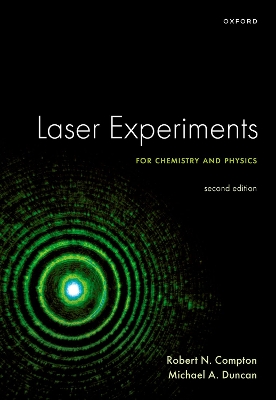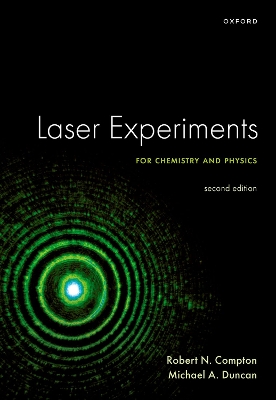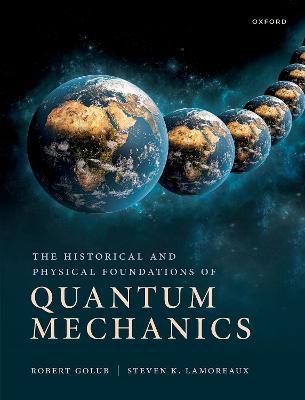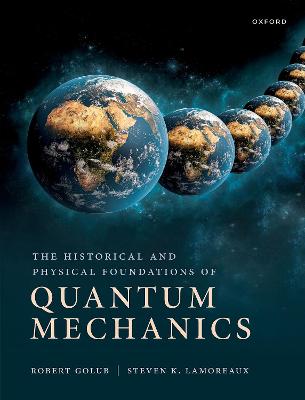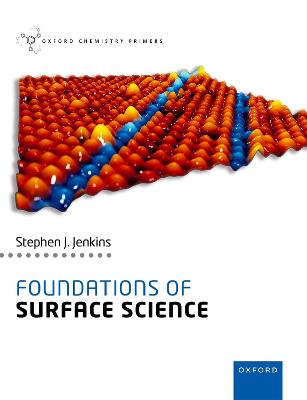Spectra of Atoms and Molecules
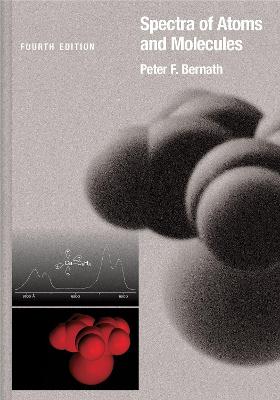 -10%
portes grátis
-10%
portes grátis
Spectra of Atoms and Molecules
Bernath, Peter F.
Oxford University Press Inc
06/2020
544
Dura
Inglês
9780190095406
15 a 20 dias
1084
Descrição não disponível.
Introduction
1.1 Waves, Particles, and Units
1.2 The Electromagnetic Spectrum
1.3 Interaction of Radiation with Matter
Molecular Symmetry
2.1 Symmetry Operations
2.2 Groups
2.3 Notation for Point Groups
Matrix Representation of Groups
3.1 Vectors and Matrices
3.2 Symmetry Operations and Position Vector Basis
3.3 Symmetry Operators and Atomic Basis Vectors
3.4 Symmetry Operators and Basis Functions
3.5 Equivalent, Reducible, and Irreducible Representations
3.6 Great Orthogonality Theorem
3.7 Character Tables
Quantum Mechanics and Group Theory
4.1 Matrix Representation of the Schrodinger Equation
4.2 Born-Oppenheimer Approximation
4.3 Symmetry of the Hamiltonian Operator
4.4 Projection Operators
4.5 Direct Product Representations
4.6 Integrals and Selection Rules
Atomic Spectroscopy
5.1 Background
5.2 Angular Momentum
5.3 The Hydrogen Atom and One-Electron Spectra
5.4 Many-Electron Atoms
5.5 Selection Rules
5.6 Atomic Spectra
5.7 Intensity of Atomic Lines
5.8 Zeeman Effect
5.9 Stark Effect
Rotational Spectroscopy
6.1 Rotation of Rigid Bodies
6.2 Diatomic and Linear Molecules
6.3 Rotational Line Intensities for Diatomic and Linear Molecules
6.4 Symmetric Tops
6.5 Asymmetric Tops
6.6 Structure Determination
Vibrational Spectroscopy
7.1 Diatomic Molecules
7.2 Vibrational Motion of Polyatomic Molecules
7.3 Selection Rules for Vibrational Transitions
7.4 Vibrational Spectra of Polyatomic Linear Molecules
7.5 Vibrational Spectra of Symmetric Tops
7.6 Vibrational Spectra of Spherical Tops
7.7 Vibrational Spectra of Asymmetric Tops
7.8 Vibration-Rotation Line Intensities
7.9 Fermi and Coriolis Perturbations
7.10 Inversion Doubling and Fluxional Behavior
Light Scattering and the Raman Effect
8.1 Background
8.2 Rotational Raman Effect
8.3 Vibration-Rotation Raman Spectroscopy
8.4 Rayleigh and Raman Intensities
Electronic Spectroscopy of Diatomics
9.1 Orbitals and States
9.2 Vibrational Structure
9.3 Rotational Structure of Diatomic Molecules
9.4 The Symmetry of Diatomic Energy Levels: Parity
9.5 Rotational Line Intensities
9.6 Dissociation, Photodissociation, and Predissociation
Electronic Spectroscopy of Polyatomics
10.1 Orbitals and States
10.2 Vibrational Structure of Electronic Transitions
10.3 Vibronic Coupling: The Herzberg-Teller Effect
10.4 Jahn-Teller Effect and Conical Intersections
10.5 Renner-Teller Effect
10.6 Nonradiative Transitions: Jablonski Diagram
10.7 Photoelectron Spectroscopy
10.8 Rotational Structure: H2CO and HCN
10.9 Intensity of Transitions
Atmospheric Spectroscopy
11.1 Introduction
11.2 Atmospheric Spectra
11.3 Radiative Transfer
11.4 Forward and Inverse Models
Astronomical Spectroscopy
12.1 Introduction
12.2 Interstellar Clouds
12.3 Stars and Brown Dwarfs
12.4 Planets, Exoplanets, and Moons
Appendices:
A. Units, Conversion, and Physical Constants
B. Character Tables
C. Direct Product Tables
D. Itnroductory Textbooks
Figure Acknowledgments
Index
1.1 Waves, Particles, and Units
1.2 The Electromagnetic Spectrum
1.3 Interaction of Radiation with Matter
Molecular Symmetry
2.1 Symmetry Operations
2.2 Groups
2.3 Notation for Point Groups
Matrix Representation of Groups
3.1 Vectors and Matrices
3.2 Symmetry Operations and Position Vector Basis
3.3 Symmetry Operators and Atomic Basis Vectors
3.4 Symmetry Operators and Basis Functions
3.5 Equivalent, Reducible, and Irreducible Representations
3.6 Great Orthogonality Theorem
3.7 Character Tables
Quantum Mechanics and Group Theory
4.1 Matrix Representation of the Schrodinger Equation
4.2 Born-Oppenheimer Approximation
4.3 Symmetry of the Hamiltonian Operator
4.4 Projection Operators
4.5 Direct Product Representations
4.6 Integrals and Selection Rules
Atomic Spectroscopy
5.1 Background
5.2 Angular Momentum
5.3 The Hydrogen Atom and One-Electron Spectra
5.4 Many-Electron Atoms
5.5 Selection Rules
5.6 Atomic Spectra
5.7 Intensity of Atomic Lines
5.8 Zeeman Effect
5.9 Stark Effect
Rotational Spectroscopy
6.1 Rotation of Rigid Bodies
6.2 Diatomic and Linear Molecules
6.3 Rotational Line Intensities for Diatomic and Linear Molecules
6.4 Symmetric Tops
6.5 Asymmetric Tops
6.6 Structure Determination
Vibrational Spectroscopy
7.1 Diatomic Molecules
7.2 Vibrational Motion of Polyatomic Molecules
7.3 Selection Rules for Vibrational Transitions
7.4 Vibrational Spectra of Polyatomic Linear Molecules
7.5 Vibrational Spectra of Symmetric Tops
7.6 Vibrational Spectra of Spherical Tops
7.7 Vibrational Spectra of Asymmetric Tops
7.8 Vibration-Rotation Line Intensities
7.9 Fermi and Coriolis Perturbations
7.10 Inversion Doubling and Fluxional Behavior
Light Scattering and the Raman Effect
8.1 Background
8.2 Rotational Raman Effect
8.3 Vibration-Rotation Raman Spectroscopy
8.4 Rayleigh and Raman Intensities
Electronic Spectroscopy of Diatomics
9.1 Orbitals and States
9.2 Vibrational Structure
9.3 Rotational Structure of Diatomic Molecules
9.4 The Symmetry of Diatomic Energy Levels: Parity
9.5 Rotational Line Intensities
9.6 Dissociation, Photodissociation, and Predissociation
Electronic Spectroscopy of Polyatomics
10.1 Orbitals and States
10.2 Vibrational Structure of Electronic Transitions
10.3 Vibronic Coupling: The Herzberg-Teller Effect
10.4 Jahn-Teller Effect and Conical Intersections
10.5 Renner-Teller Effect
10.6 Nonradiative Transitions: Jablonski Diagram
10.7 Photoelectron Spectroscopy
10.8 Rotational Structure: H2CO and HCN
10.9 Intensity of Transitions
Atmospheric Spectroscopy
11.1 Introduction
11.2 Atmospheric Spectra
11.3 Radiative Transfer
11.4 Forward and Inverse Models
Astronomical Spectroscopy
12.1 Introduction
12.2 Interstellar Clouds
12.3 Stars and Brown Dwarfs
12.4 Planets, Exoplanets, and Moons
Appendices:
A. Units, Conversion, and Physical Constants
B. Character Tables
C. Direct Product Tables
D. Itnroductory Textbooks
Figure Acknowledgments
Index
Este título pertence ao(s) assunto(s) indicados(s). Para ver outros títulos clique no assunto desejado.
Introduction
1.1 Waves, Particles, and Units
1.2 The Electromagnetic Spectrum
1.3 Interaction of Radiation with Matter
Molecular Symmetry
2.1 Symmetry Operations
2.2 Groups
2.3 Notation for Point Groups
Matrix Representation of Groups
3.1 Vectors and Matrices
3.2 Symmetry Operations and Position Vector Basis
3.3 Symmetry Operators and Atomic Basis Vectors
3.4 Symmetry Operators and Basis Functions
3.5 Equivalent, Reducible, and Irreducible Representations
3.6 Great Orthogonality Theorem
3.7 Character Tables
Quantum Mechanics and Group Theory
4.1 Matrix Representation of the Schrodinger Equation
4.2 Born-Oppenheimer Approximation
4.3 Symmetry of the Hamiltonian Operator
4.4 Projection Operators
4.5 Direct Product Representations
4.6 Integrals and Selection Rules
Atomic Spectroscopy
5.1 Background
5.2 Angular Momentum
5.3 The Hydrogen Atom and One-Electron Spectra
5.4 Many-Electron Atoms
5.5 Selection Rules
5.6 Atomic Spectra
5.7 Intensity of Atomic Lines
5.8 Zeeman Effect
5.9 Stark Effect
Rotational Spectroscopy
6.1 Rotation of Rigid Bodies
6.2 Diatomic and Linear Molecules
6.3 Rotational Line Intensities for Diatomic and Linear Molecules
6.4 Symmetric Tops
6.5 Asymmetric Tops
6.6 Structure Determination
Vibrational Spectroscopy
7.1 Diatomic Molecules
7.2 Vibrational Motion of Polyatomic Molecules
7.3 Selection Rules for Vibrational Transitions
7.4 Vibrational Spectra of Polyatomic Linear Molecules
7.5 Vibrational Spectra of Symmetric Tops
7.6 Vibrational Spectra of Spherical Tops
7.7 Vibrational Spectra of Asymmetric Tops
7.8 Vibration-Rotation Line Intensities
7.9 Fermi and Coriolis Perturbations
7.10 Inversion Doubling and Fluxional Behavior
Light Scattering and the Raman Effect
8.1 Background
8.2 Rotational Raman Effect
8.3 Vibration-Rotation Raman Spectroscopy
8.4 Rayleigh and Raman Intensities
Electronic Spectroscopy of Diatomics
9.1 Orbitals and States
9.2 Vibrational Structure
9.3 Rotational Structure of Diatomic Molecules
9.4 The Symmetry of Diatomic Energy Levels: Parity
9.5 Rotational Line Intensities
9.6 Dissociation, Photodissociation, and Predissociation
Electronic Spectroscopy of Polyatomics
10.1 Orbitals and States
10.2 Vibrational Structure of Electronic Transitions
10.3 Vibronic Coupling: The Herzberg-Teller Effect
10.4 Jahn-Teller Effect and Conical Intersections
10.5 Renner-Teller Effect
10.6 Nonradiative Transitions: Jablonski Diagram
10.7 Photoelectron Spectroscopy
10.8 Rotational Structure: H2CO and HCN
10.9 Intensity of Transitions
Atmospheric Spectroscopy
11.1 Introduction
11.2 Atmospheric Spectra
11.3 Radiative Transfer
11.4 Forward and Inverse Models
Astronomical Spectroscopy
12.1 Introduction
12.2 Interstellar Clouds
12.3 Stars and Brown Dwarfs
12.4 Planets, Exoplanets, and Moons
Appendices:
A. Units, Conversion, and Physical Constants
B. Character Tables
C. Direct Product Tables
D. Itnroductory Textbooks
Figure Acknowledgments
Index
1.1 Waves, Particles, and Units
1.2 The Electromagnetic Spectrum
1.3 Interaction of Radiation with Matter
Molecular Symmetry
2.1 Symmetry Operations
2.2 Groups
2.3 Notation for Point Groups
Matrix Representation of Groups
3.1 Vectors and Matrices
3.2 Symmetry Operations and Position Vector Basis
3.3 Symmetry Operators and Atomic Basis Vectors
3.4 Symmetry Operators and Basis Functions
3.5 Equivalent, Reducible, and Irreducible Representations
3.6 Great Orthogonality Theorem
3.7 Character Tables
Quantum Mechanics and Group Theory
4.1 Matrix Representation of the Schrodinger Equation
4.2 Born-Oppenheimer Approximation
4.3 Symmetry of the Hamiltonian Operator
4.4 Projection Operators
4.5 Direct Product Representations
4.6 Integrals and Selection Rules
Atomic Spectroscopy
5.1 Background
5.2 Angular Momentum
5.3 The Hydrogen Atom and One-Electron Spectra
5.4 Many-Electron Atoms
5.5 Selection Rules
5.6 Atomic Spectra
5.7 Intensity of Atomic Lines
5.8 Zeeman Effect
5.9 Stark Effect
Rotational Spectroscopy
6.1 Rotation of Rigid Bodies
6.2 Diatomic and Linear Molecules
6.3 Rotational Line Intensities for Diatomic and Linear Molecules
6.4 Symmetric Tops
6.5 Asymmetric Tops
6.6 Structure Determination
Vibrational Spectroscopy
7.1 Diatomic Molecules
7.2 Vibrational Motion of Polyatomic Molecules
7.3 Selection Rules for Vibrational Transitions
7.4 Vibrational Spectra of Polyatomic Linear Molecules
7.5 Vibrational Spectra of Symmetric Tops
7.6 Vibrational Spectra of Spherical Tops
7.7 Vibrational Spectra of Asymmetric Tops
7.8 Vibration-Rotation Line Intensities
7.9 Fermi and Coriolis Perturbations
7.10 Inversion Doubling and Fluxional Behavior
Light Scattering and the Raman Effect
8.1 Background
8.2 Rotational Raman Effect
8.3 Vibration-Rotation Raman Spectroscopy
8.4 Rayleigh and Raman Intensities
Electronic Spectroscopy of Diatomics
9.1 Orbitals and States
9.2 Vibrational Structure
9.3 Rotational Structure of Diatomic Molecules
9.4 The Symmetry of Diatomic Energy Levels: Parity
9.5 Rotational Line Intensities
9.6 Dissociation, Photodissociation, and Predissociation
Electronic Spectroscopy of Polyatomics
10.1 Orbitals and States
10.2 Vibrational Structure of Electronic Transitions
10.3 Vibronic Coupling: The Herzberg-Teller Effect
10.4 Jahn-Teller Effect and Conical Intersections
10.5 Renner-Teller Effect
10.6 Nonradiative Transitions: Jablonski Diagram
10.7 Photoelectron Spectroscopy
10.8 Rotational Structure: H2CO and HCN
10.9 Intensity of Transitions
Atmospheric Spectroscopy
11.1 Introduction
11.2 Atmospheric Spectra
11.3 Radiative Transfer
11.4 Forward and Inverse Models
Astronomical Spectroscopy
12.1 Introduction
12.2 Interstellar Clouds
12.3 Stars and Brown Dwarfs
12.4 Planets, Exoplanets, and Moons
Appendices:
A. Units, Conversion, and Physical Constants
B. Character Tables
C. Direct Product Tables
D. Itnroductory Textbooks
Figure Acknowledgments
Index
Este título pertence ao(s) assunto(s) indicados(s). Para ver outros títulos clique no assunto desejado.


